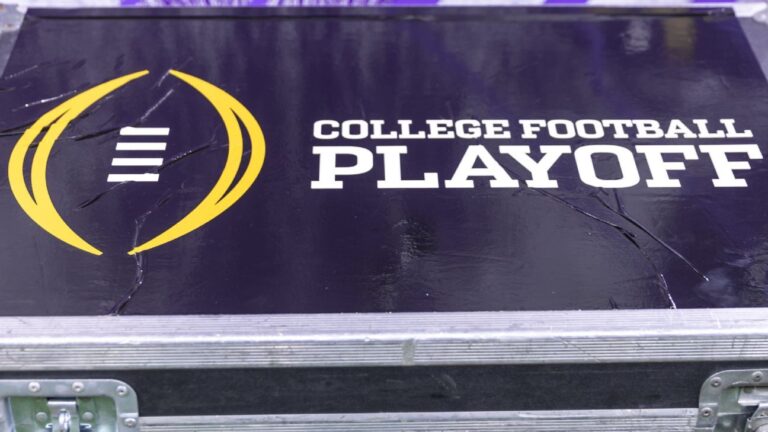The College Football Playoff is moving an important step closer to the 14-team playoff expected to begin in 2026. The 10 FBS conferences and Notre Dame are working to agree to and notify the next contract in time for Friday's deadline. The CFP is considering whether to participate in the playoffs after 2026.
The leagues and Notre Dame plan to sign a legal agreement by noon Friday, multiple sources told ESPN on Thursday. Starting in 2026, the new agreement will codify further economic separation of the expanded Big Ten and SEC from other college athletic organizations. G5 members are in a difficult position without negotiating powers, but sources suggest they have no intention of opting out of the CFP.
“It's like a godfather offer you can't refuse,” one Group 5 competition director told ESPN on Thursday.
The distribution of funds for the anticipated 14-team playoffs will be fundamentally different from previous playoffs. For example, on an annual basis, the Big Ten and SEC would earn more than $21 million per school, which is higher than the roughly $5.5 million Power 5 leagues currently pay.
In the ACC, each school will receive more than $13 million per year, and the Big 12 will receive more than $12 million per school. Notre Dame is expected to earn more than $12 million as well, with sources telling ESPN there will be financial incentives for independent teams that reach the CFP. (Other leagues will no longer have participation bonuses, a detail that dissatisfied some Group 5 leaders.)
Revenue for the five-school group (American, Conference USA, MAC, Mountain West and Sun Belt) will increase from the current $1.5 million to just under $1.8 million. AAC Commissioner Mike Aresco, who has been the plan's most outspoken critic, has not been able to garner enough support from other commissioners to fight it, according to multiple sources.
Officials cautioned that it would be difficult to compare numbers because of the lack of transparency over the details of the next round of spending and allocation. But generally speaking, these are annual distribution amounts.
It is important to remember that these numbers indicate a change in circumstances, with funds from historic bowl relationships now being redeployed through the CFP. This is a different scenario for Notre Dame, which didn't have traditional bowl payouts.
The Big Ten and SEC have the most CFP representation with a combined 34 teams, so they also have the most influence in the discussion. SEC Commissioner Greg Sankey, who met with conference presidents and chancellors this week, said 40% of the teams in his conference were able to make the playoffs.
This is also why the ACC is slightly better in revenue than the Big 12, with the ACC having eight CFP semifinalists (including Notre Dame as a league member in 2020) Meanwhile, TCU is the only Big 12 team to advance to the CFP semifinals. He will be in the Big 12 next season. Cincinnati, a member of the Big 12, qualified for the CFP in the 2020 season while a member of the American Athletic Conference.
The wide disparity in income from top to bottom has already sparked frustration and pushback from schools outside the Big Ten and SEC. To alleviate some of those concerns, officials said, the 2028 contract agreement will be signed in 2028 to give the commissioner and Notre Dame leadership a chance to reevaluate the contract agreement based on each league's performance to that point. It is said that a “consideration'' clause has been added for 2020. There is also a provision that would allow the schedule to be accelerated if another “substantive readjustment” occurs.
If the 10 FBS conferences and Notre Dame agree to work together as expected, the next step will be finalizing the long-awaited television deal with ESPN. ESPN is poised to spend an average of nearly $1.3 billion on the playoffs over six seasons starting in 2026. The deal includes the final two years of the current CFP contract, plus a new six-year deal for the next iteration of the playoffs, sources told ESPN.
The CFP plans to announce a 12-team structure for the 2024 and 2025 seasons. Details of the field, expected to be 14 teams, will not be finalized until the television deal is finalized.
What format that field will take has not yet been determined. The format for the next two years will consist of his five automatic qualifiers and his seven at-large bids from the conference's top five champions. It is expected to be a 14-team playoff, and the format is expected to continue to be debated.
The timeline for these important decisions remains uncertain, as it is unclear whether college sports leaders will pursue any edition of the 12-team playoffs or decide in the coming months.
This week's internal deadline was an unusual step forward for an organization that has so far relied on unanimity to advance significant changes to the CFP — not just for the 10 FBS commissioners, but for each of the members representing them on the CFP. The management committee, including the president and prime minister, was unanimous. However, with a new contract due to be signed in 2026, decisions being made now for the future mean that their desire to participate in that contract outweighs any perceived unfairness in the process or form. It is based on whether or not.


